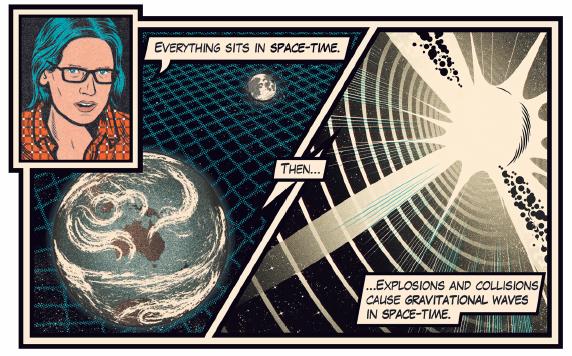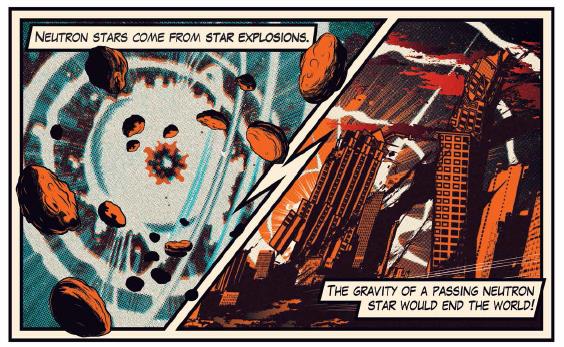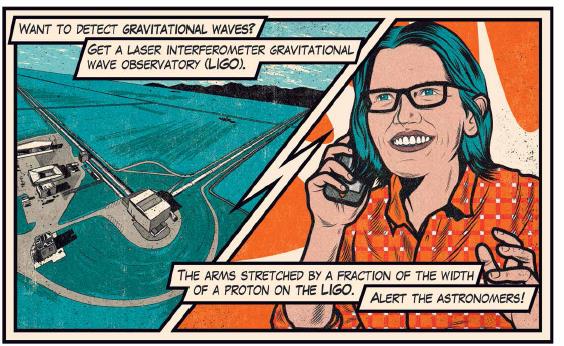First for radio astronomers in gravitational waves breakthrough

An artist's impression of Associate Professor Tara Murphy encountering gravitational waves.
Think back to 17 August 2017. That was the first day electromagnetic radiation and gravitational waves from the same event were detected here on Earth. Our tiny planet and everything on it, was stretched up by the gravitational wave peaks and squeezed by the troughs. Did you feel it?
Probably not. In fact, you couldn’t have. The waves had travelled such a long way, their power was beyond minuscule. We only know they arrived at all because of two highly complex structures in the United States called the Laser Interferometer Gravitational-Wave Observatory (LIGO).
LIGO was designed specifically to sense gravitational waves by measuring movement on the scale of one 10,000th the width of a proton – which is even smaller than an atom. By detecting that vanishingly small movement caused by gravitational waves, LIGO started a new chapter in scientific history.
The waves might have passed through us unnoticed, but their detection was an earthquake to the scientific community. Almost 100 years earlier, the Father of Relativity, Albert Einstein, had predicted the existence of gravitational waves. Now, finally, they had been detected, adding more evidence for his theory.
The waves started their light-speed journey 130 million years ago, at a time on Earth when plants were first experimenting with flowers and the earliest mammals were trying to avoid being eaten by dinosaurs. The waves were generated when two neutron stars that had been locked in each other’s gravitational fields finally went into a death spiral and collided.

Associate Professor Tara Murphy
At that moment, several things happened that were nothing less than mind-boggling: more energy was released than by our Sun in its nearly 10-billion-year lifetime; atoms slammed together in a way that produced enough gold to make an entire planet; and an object was created of such density that a single teaspoon of it would weigh about a billion tonnes.
Considering how long astronomers had waited for this discovery, the timing wasn’t great for astronomer, Associate Professor Tara Murphy (BSc (Adv) ’00 CertEdStud ’12). As one of the most important events in the history of science unfolded, she was at a conference in Washington, 15,000 kilometres away from her team and the equipment she needed to participate.
As she eagerly made her way home, she took every chance to phone her colleagues, postdoctoral researcher, Dr Christene Lynch and CSIRO astronomer, Dr Keith Bannister (PhD ’12), and plan how to grapple with the breakthrough event.
The key task was to scan the heavens looking for the origin point of the waves which would allow a lot more information to be collected. For example, by examining the visible light from the collision, astronomers were able to confirm the creation of heavy metals, including that planet-sized amount of gold.
The search was all-consuming for Murphy, who remembers having a fascination with science from an early age. Her parents hadn’t finished high school, but they encouraged her to pursue the interest. Finding herself at the University of Sydney was transformative and she still gets emotional talking about it. "I read about science my whole life but never actually discussed it with anyone except my teachers. Then I got to uni and it was like – oh wow. This is my world."
It was extremely intense. We worked around the clock, and didn’t sleep for the first couple of days.
About 100 international teams, including Murphy’s, were looking for the new object in space that was formed by the collision of the neutron stars. It would be generating radiation like gamma-rays and X-rays and, of course, gravitational waves. As radio astronomers, Murphy’s team was looking specifically for radio waves.
The search generated some tension within the international astronomy community. Allowing that work done in disciplines like medicine, chemistry and physics can have commercial applications, researchers are often secretive about what they do. Astronomy hasn’t been like that.
“We have a strong history of international collaboration, where many telescopes have an open skies policy,” Murphy says with some pride. “We share our data.”
Things were different this time. LIGO was put together by a team from largely non-astronomy areas of physics. When it began operating, LIGO offered to tell any astronomer of a detection, provided they signed a memorandum of understanding and agreed to keep the news secret. LIGO didn’t want scientific review by media.
Some astronomers, including Murphy’s team, signed the agreement. Some didn’t. Murphy eventually found herself in the difficult position of not being able to tell even close colleagues about this literally astronomical event. Though, as she points out, many people who didn’t sign still figured parts of it out.
"So there's this really boring galaxy and suddenly hundreds of astronomers are pointing their telescopes at it", she says. "There are only so many reasons why that would happen".
Murphy also couldn’t tell anyone that her team was part of finding that needle in a hundred haystacks – the origin point of the gravitational waves from galaxy NGC 4993 in the Hydra constellation. She downplays the achievement. “There is a huge component of luck,” she says. “This is an area of research we’ve been working on for years. We were very prepared.”
Another consideration for Murphy, has been how our new understanding of gravitational waves might impact on one of astronomy’s Holy Grails – what happened just after the Big Bang. We can’t extract data from the visible light that still travels towards us from that event, because the fog of the early Universe is opaque. But unlike light, gravitational waves should be able to travel to us relatively unencumbered.
“So if …” Murphy pauses, “big if – if, in the far future, the detectors were sensitive enough, we would be able to detect primordial gravitational waves from the Big Bang itself.”
For a quiet moment, she contemplates the possibility.
Gravitational waves: explained
Below is a visual explanation of the concepts Associate Professor Murphy uses in her work.

Imagine a rubber sheet, strung taut. Throw a basketball onto the sheet and it dips where the ball lands. Throw a tennis ball nearby and it gets caught in the dip, moving towards the basketball. That’s how gravity works between all objects in the Universe. The rubber sheet, very broadly, represents what’s called space-time. When two massive objects, like neutron stars, explode or collide, they cause gravitational waves in the space-time fabric.

Formed when a star explodes and the core collapses in on itself, neutron stars are about 20km in diameter but contain the mass of about 500,000 Earths. Neutron star gravity is about one billion times stronger than Earth gravity, crushing the protons and electrons in its own atoms together so they form neutrons – hence ‘neutron star’. That same gravity would destroy the Earth if a neutron star were to enter our planetary neighbourhood.

The two 4km-long arms of LIGO shelter a laser beam. When the gravitational waves passed through the Earth, they stretched the arms of LIGO a tiny fraction of the width of a proton. This meant the laser took very slightly longer to reach the end of the arm. This also happened at a second LIGO facility 3000km away, confirming the reading wasn’t a local vibration. With confirmation, notifications went out to participating astronomers.
The comic book visuals for this story were inspired by the 1960s cartoon strip Frontiers of Science, which was connected with the University of Sydney, and syndicated in 600 newspapers around the world. You can see the original comic strips and find out more at frontiers.library.usyd.edu.au
Written by George Dodd
Illustrated by Diego Patiño

